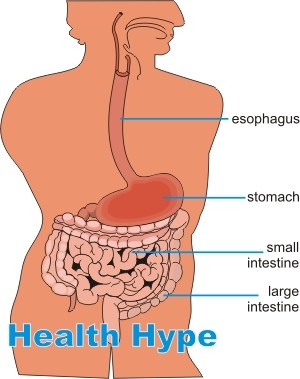Esophagus Problems and Esophageal Pain
The Esophagus
The esophagus is the long narrow tube of the upper gastrointestinal tract commonly referred to as the food pipe. It connects the throat to the stomach – starting from the lower parts of the neck and running down the chest (thoracic) cavity throught the diaphragm and continues into the stomach immediately after entering the abdominal cavity. The human esophagus is about 25 to 30 centimeters long.
It is a muscular tube that is able to propel food rapidly into the stomach. The inner lining known as the esophageal mucosa contains a large number of mucus producing cells. Small mucus-producing esophageal glands are also located within the submucosa. The mucus that is secreted helps to lubricate the food passing into the stomach. There are two areas which control the movement of food and drink into and out of the esophagus – the upper esoophageal sphincter (UES) and lower esophageal sphincter (LES).
The upper esophageal sphincter (UES) lies at the junction of the pharynx and esophagus. It is under voluntary control and allows food and drink to pass into the esophagus during swallowing. However, opening and closing of the upper esophageal sphincter is often not done consciously. The lower esophageal sphincter (LES) lies at the junction of the lower part of the esophagus and stomach. It is not under voluntary control. It allows food and fluids to enter the stomach but prevents the acidic stomach contents from leaking into the esophagus.
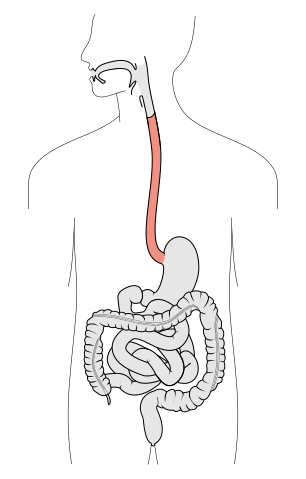
What are esophageal problems?
There are a host of different problems with the esophagus which mainly affect the inner lining and middle muscular layer. The term ‘esophageal problems’ does not indicate a specific condition affecting the esophagus. Problems with the inner lining are mainly due to inflammation and growths. Deeper lying problems most commonly affects the muscles in the esophageal wall upsetting normal esophageal motility and opening or closing of the upper or lower esophageal sphincters. Esophageal problems are not a single entity and therefore there is no specific treatment unless the underlying disease is identified.
Symptoms of Esophagus Problems
The signs and symptoms of esophageal problems depends on the underlying condition.
- Esophageal pain
- Painful swallowing (odynophagia)
- Difficulty swallowing (dysphagia)
- Regurgitation
- Nausea
- Changes in appetite
- Heavy sensation in the chest
Esophageal pain includes heartburn which varies from a burning sensation or discomfort to intense burning pain. This is one of the most common and prominent symptoms of esophagus problems. However, it is important to ensure that esophageal pain – most commonly experienced as central chest pain – is emanating from the esophagus and none of the surrounding vitals organs in the chest cavity such as the heart.
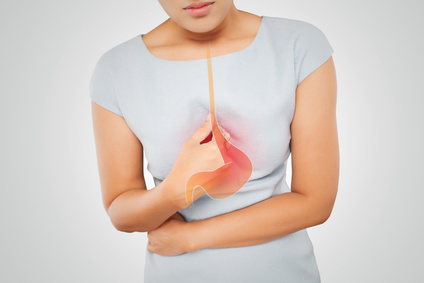
Esophagus Pain
Pain in the esophagus is often difficult to identify unless it occurs during swallowing (odynophagia). Since most of the esophagus runs through the chest cavity, esophageal pain is often described as chest pain and more serious causes like disorders of the heart, great vessels and airways need to first be excluded if pain is the only presenting symptom. Differentiating between cardiac and non-cardiac chest pain is therefore important as the former is often a medical emergency.
Esophageal pain presents as pain in the center of the chest, sometimes also described as breastbone pain. It may accompany swallowing, aggravate in certain positions or occur spontaneously and persist for long periods of time. Pain in the esophagus is often related to inflammation (esophagitis) although there are some non-inflammatory causes of esophageal pain.
The character of the pain may vary – a burning chest pain is often associated with gastric acid (heartburn) while a sharp pain may be related to a foreign body lodged in the esophagus or esophageal tears. Dysphagia (difficulty swallowing) may also be seen in esophageal pain, either due to impaired esophageal motility, mechanical obstruction or apprehension over swallowing due to the pain.
Causes of Esophagus Problems
Common Causes
The most common esophagus problems includes :
- Esophagitis which is the inflammation of the esophagus usually limited to the inner lining. There are several different causes including infections, medication and autoimmune factors. However, a common cause is acid reflux which is known as reflux esophagitis.
- Injury to the esophagus may be due to a number of causes. A foreign body that enters the esophagus (like a fish bone or small sharp toys ingested by infants) can lodge in the esophageal lining or cause tears. Very hot foods or drink may also cause trauma to the esophageal lining.
- Esophageal ulcers are the formation of open sores in the wall of the esophagus. It is mainly due to the same causes as stomach ulcers and duodenal ulcers (peptic ulcer disease). Acid reflux is the main cause and ulcers tend to follow prolonged or severe esophagitis.
- Gastroesophageal reflux disease (GERD) is mainly a problem with lower esophageal sphincter (LES) dysfunction thereby allowing stomach acid to flow backwards into the esophagus. It causes esophagitis and esophageal ulcers.
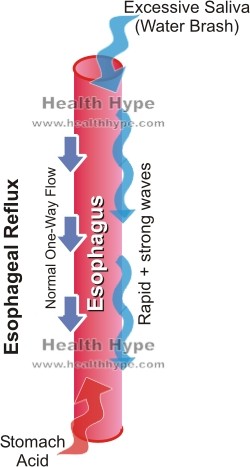
Other Causes
Other less common causes of esophagus problems includes conditions such as :
- Achalasia is a disorder where the LES does not relax sufficiently to allow food to pass through into the stomach.
- Barrett esophagus is a condition where the cells of the lower esophagus changes due to repeated irritation as a result of acid reflux.
- Esophageal cancer is a malignant growth of the esophageal tissue. It can arise with certain conditions like Barrett esophagus.
- Esophageal ring where there is a ring-like formation of tissue causing some narrowing of the esophagus. It occurs in the lower esophagus.
- Esophageal web is a condition where there is growth of abnormal tissue in the upper end of the esophagus.
- Esophageal spasms – diffuse esophageal spasm and nutcracker syndrome – often results in chest pain. This occurs as a result of the esophageal muscles constricting abnormally or excessively. The spasm may result in pain.
- Mallory-Weiss tear is where there is a tear in the esophageal lining, usually the part close to the stomach. It is mainly causes by forceful retching or persistent vomiting.
- Varices are enlarged and congested with blood which is usually seen with cirrhosis (liver disease).
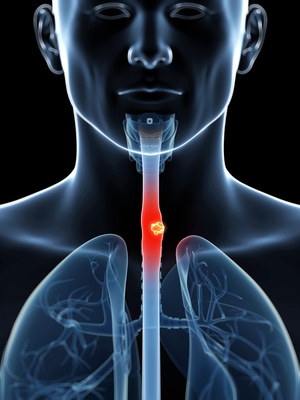
Diagnosis of Esophagus Problems
History is an important factor in diagnosing any esophageal problems. This can be confirmed more conclusively with various investigations such as :
- Barium swallow where a radiocontrast dye is used to highlight the contours of the esophagus.
- Upper gastrointestinal (GI) endoscopy where a thin tube with a light and a camera at the end are used to visualize the esophagus.
- pH monitoring to record the changes in the acidity or alkalinity of the esophageal lumen.
Treatment of Esophagus Problems
There is no specific treatment that can be used for all esophagus problems. However, most conditions are due to stomach acid – recurrent reflux into the esophagus. Medication for treating these esophageal problems associated with stomach acid includes :
- Antacids to neutralize the stomach acid.
- Proton pump inhibitors (PPIs) and H2-blockers which suppress gastric acid secretion.
- Metoclopramide to speed up emptying of the stomach.
- Sucralfate which coats ulcers thereby protecting it until it heals.
References
- Esophagus Disorders. NIH.gov
- Diseases of the Esophagus. Medical University of South Carolina

